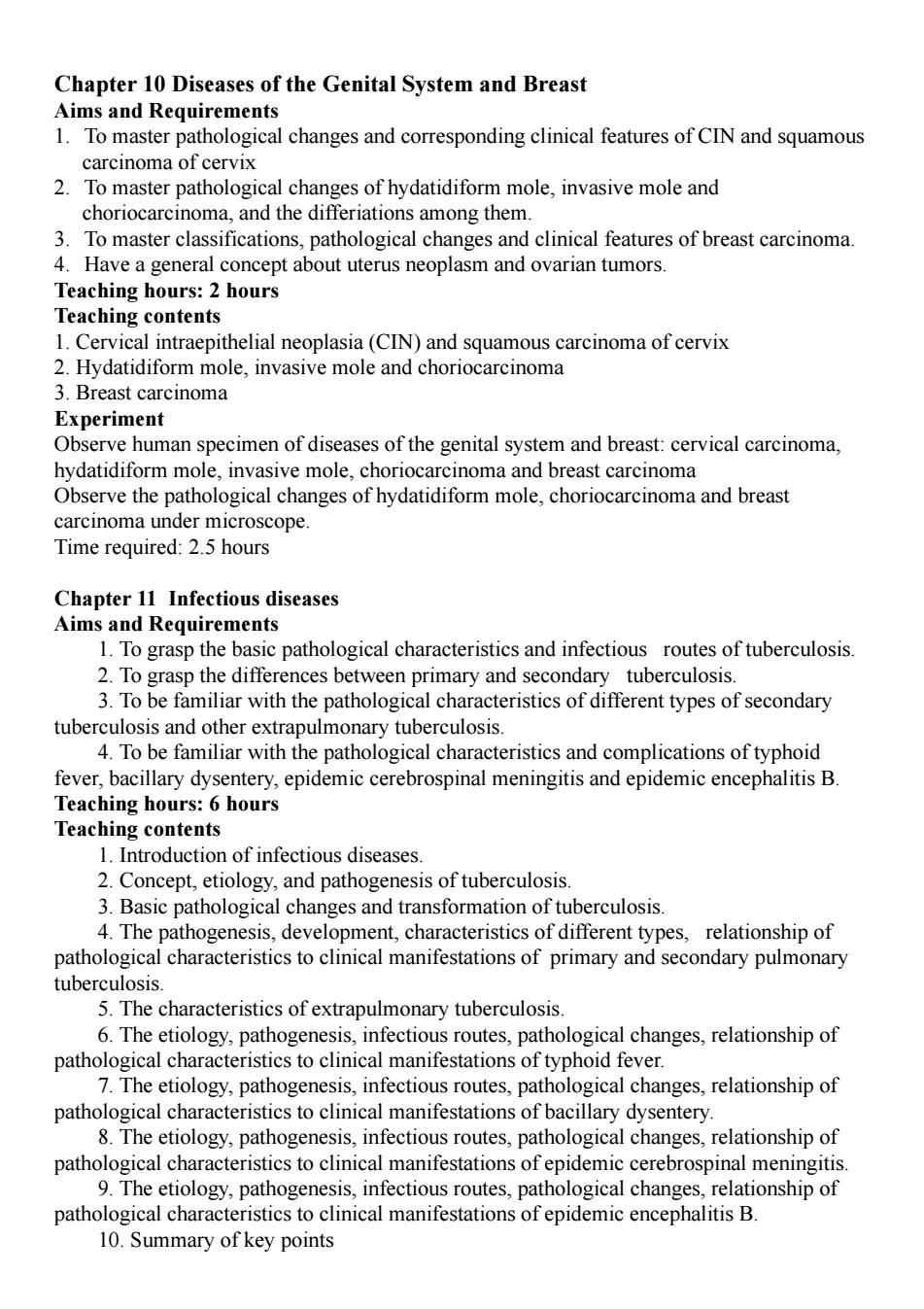正在加载图片...

Chapter 10 Diseases of the Genital System and Breast Aims and Requirements 1.To master pathological changes and corresponding clinical features of CIN and squamous carcinoma of cervix 2.To master pathological changes of hydatidiform mole,invasive mole and choriocarcinoma,and the differiations among them. 3.To master classifications,pathological changes and clinical features of breast carcinoma. 4.Have a general concept about uterus neoplasm and ovarian tumors. Teaching hours:2 hours Teaching contents 1.Cervical intraepithelial neoplasia(CIN)and squamous carcinoma of cervix 2.Hydatidiform mole,invasive mole and choriocarcinoma 3.Breast carcinoma Experiment Observe human specimen of diseases of the genital system and breast:cervical carcinoma, hydatidiform mole,invasive mole,choriocarcinoma and breast carcinoma Observe the pathological changes of hydatidiform mole,choriocarcinoma and breast carcinoma under microscope. Time required:2.5 hours Chapter 11 Infectious diseases Aims and Requirements 1.To grasp the basic pathological characteristics and infectious routes of tuberculosis. 2.To grasp the differences between primary and secondary tuberculosis. 3.To be familiar with the pathological characteristics of different types of secondary tuberculosis and other extrapulmonary tuberculosis. 4.To be familiar with the pathological characteristics and complications of typhoid fever,bacillary dysentery,epidemic cerebrospinal meningitis and epidemic encephalitis B. Teaching hours:6 hours Teaching contents 1.Introduction of infectious diseases. 2.Concept,etiology,and pathogenesis of tuberculosis. 3.Basic pathological changes and transformation of tuberculosis. 4.The pathogenesis,development,characteristics of different types,relationship of pathological characteristics to clinical manifestations of primary and secondary pulmonary tuberculosis. 5.The characteristics of extrapulmonary tuberculosis. 6.The etiology,pathogenesis,infectious routes,pathological changes,relationship of pathological characteristics to clinical manifestations of typhoid fever. 7.The etiology,pathogenesis,infectious routes,pathological changes,relationship of pathological characteristics to clinical manifestations of bacillary dysentery. 8.The etiology,pathogenesis,infectious routes,pathological changes,relationship of pathological characteristics to clinical manifestations of epidemic cerebrospinal meningitis. 9.The etiology,pathogenesis,infectious routes,pathological changes,relationship of pathological characteristics to clinical manifestations of epidemic encephalitis B. 10.Summary of key pointsChapter 10 Diseases of the Genital System and Breast Aims and Requirements 1. To master pathological changes and corresponding clinical features of CIN and squamous carcinoma of cervix 2. To master pathological changes of hydatidiform mole, invasive mole and choriocarcinoma, and the differiations among them. 3. To master classifications, pathological changes and clinical features of breast carcinoma. 4. Have a general concept about uterus neoplasm and ovarian tumors. Teaching hours: 2 hours Teaching contents 1. Cervical intraepithelial neoplasia (CIN) and squamous carcinoma of cervix 2. Hydatidiform mole, invasive mole and choriocarcinoma 3. Breast carcinoma Experiment Observe human specimen of diseases of the genital system and breast: cervical carcinoma, hydatidiform mole, invasive mole, choriocarcinoma and breast carcinoma Observe the pathological changes of hydatidiform mole, choriocarcinoma and breast carcinoma under microscope. Time required: 2.5 hours Chapter 11 Infectious diseases Aims and Requirements 1. To grasp the basic pathological characteristics and infectious routes of tuberculosis. 2. To grasp the differences between primary and secondary tuberculosis. 3. To be familiar with the pathological characteristics of different types of secondary tuberculosis and other extrapulmonary tuberculosis. 4. To be familiar with the pathological characteristics and complications of typhoid fever, bacillary dysentery, epidemic cerebrospinal meningitis and epidemic encephalitis B. Teaching hours: 6 hours Teaching contents 1. Introduction of infectious diseases. 2. Concept, etiology, and pathogenesis of tuberculosis. 3. Basic pathological changes and transformation of tuberculosis. 4. The pathogenesis, development, characteristics of different types, relationship of pathological characteristics to clinical manifestations of primary and secondary pulmonary tuberculosis. 5. The characteristics of extrapulmonary tuberculosis. 6. The etiology, pathogenesis, infectious routes, pathological changes, relationship of pathological characteristics to clinical manifestations of typhoid fever. 7. The etiology, pathogenesis, infectious routes, pathological changes, relationship of pathological characteristics to clinical manifestations of bacillary dysentery. 8. The etiology, pathogenesis, infectious routes, pathological changes, relationship of pathological characteristics to clinical manifestations of epidemic cerebrospinal meningitis. 9. The etiology, pathogenesis, infectious routes, pathological changes, relationship of pathological characteristics to clinical manifestations of epidemic encephalitis B. 10. Summary of key points